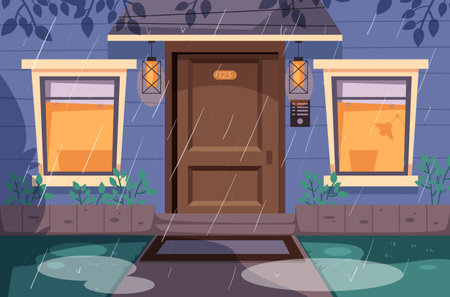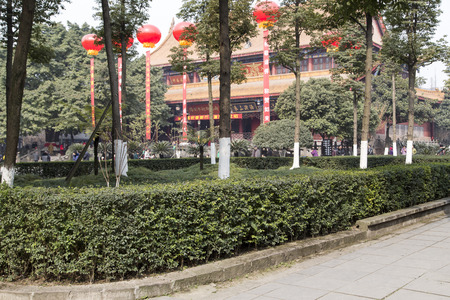1. Neglected Entryways and Pathways
When it comes to backyard feng shui, one of the most overlooked mistakes is ignoring the entryways and garden paths. In American homes, the backyard is often a place for barbecues, family gatherings, and relaxing weekends. However, if your pathways are cluttered with garden tools, toys, or overgrown plants, it can block the natural flow of energy—what feng shui calls “chi.” A messy entryway doesn’t just look uninviting; it actually creates stagnant energy that can affect the overall vibe of your outdoor space.
Why Entryways and Paths Matter
In feng shui, the entryway is like the mouth of your home—it’s where good energy enters. This applies not only to your front door but also to any gates or paths leading into your backyard. When these areas are neat and well-maintained, they invite positive energy (and guests!) to come in and linger. On the other hand, blocked or neglected paths can make your backyard feel closed off and less welcoming.
Common Mistakes with Outdoor Entryways and Paths
| Mistake | How It Disrupts Energy | Simple Fixes |
|---|---|---|
| Cluttered walkways (tools, hoses, bikes) | Blocks smooth movement; feels chaotic | Install storage hooks or bins near entrance |
| Overgrown plants blocking paths | Stagnant chi; feels uninviting | Regular trimming and shaping of greenery |
| Poor lighting at night | Makes space feel unsafe and gloomy | Add solar path lights or string lights for a cozy vibe |
| Dirt or debris buildup on steps or stones | Makes entry feel neglected; slippery hazards | Sweep regularly; power-wash seasonally |
| No clear path from gate to main seating area | Confusing flow; guests may avoid entering fully | Create a defined walkway with pavers or gravel |
American-Friendly Tips for Welcoming Entryways
- Add a doormat: A clean welcome mat by your backyard gate instantly makes guests feel invited.
- Use decorative planters: Flank your entry with colorful flowers or easy-care succulents for curb appeal and positive vibes.
- Keep it accessible: Make sure wheelbarrows, recycling bins, or sports equipment don’t block key paths—designate a spot away from main walkways.
- Seasonal decor: Swap out decorations for holidays or seasons to keep the space feeling fresh and lively.
- Create a sense of arrival: Consider adding an archway or trellis at the entrance for a charming transition into your outdoor oasis.
If you take just a little time to care for your backyard’s entryways and paths, you’ll notice how much more inviting and energetic your outdoor space feels—not just to visitors, but to everyone living in your home.
2. Mismatched Outdoor Furniture Placement
How Outdoor Furniture Can Disrupt Feng Shui
Outdoor furniture is a staple in American backyards—from cozy fire pit circles to stylish patio dining sets. But when it comes to Feng Shui, where and how you place your furniture matters just as much as what you choose. It’s easy to accidentally block the natural flow of energy (or “Chi”) with bulky seating, or create awkward social vibes with poorly arranged chairs.
Common Mistakes in Outdoor Furniture Arrangement
| Mistake | Why It’s a Problem | Feng Shui Fix |
|---|---|---|
| Blocking Pathways with Large Sofas or Tables | Blocks Chi from flowing smoothly through the space, making the area feel cramped or uncomfortable. | Keep main walkways clear; position large pieces along edges instead of central paths. |
| Isolated Chairs Away from Social Areas | Breaks up connection and makes guests feel left out, disrupting harmony and togetherness. | Group seating in clusters that encourage conversation, such as U-shapes or semicircles. |
| Pushing All Furniture Against Fences or Walls | Creates stagnant energy pockets and makes spaces feel boxed-in. | Float some pieces slightly away from boundaries to let Chi circulate all around. |
| Mismatched Heights (e.g., tall loungers with low coffee tables) | Leads to visual imbalance and discomfort for users, breaking up the flow of energy. | Select furniture with similar heights or use cushions/risers to even things out. |
Practical Tips for Popular American Patio Layouts
L-Shaped Patios
Avoid cramming all seating into one corner. Instead, split seating into two conversation zones—one along each leg of the “L”—for better balance and easier movement.
Decks with Railings
Don’t push every piece against the rails. Leave a few inches so energy can flow behind seating. Place a small plant or lantern near corners to keep Chi moving.
Open Lawns and Fire Pit Areas
Avoid scattering single chairs at random. Arrange seats in gentle curves or circles around focal points like fire pits to create welcoming, inclusive energy.
Quick Checklist for Feng Shui-Friendly Outdoor Arrangements:
- Clear main pathways for easy movement
- Create cozy, connected seating groups
- Avoid placing backs directly to doors or main entries
- Add soft elements like cushions or outdoor rugs for comfort and balance
- Incorporate greenery nearby for fresh energy boost

3. Ignoring Water Features and Their Placement
Why Water Features Matter in Feng Shui
In Feng Shui, water symbolizes abundance, prosperity, and positive energy flow. When thoughtfully incorporated into backyard or outdoor spaces, water features like fountains, ponds, pools, or even simple birdbaths can attract good fortune and create a calming atmosphere. However, if these features are neglected or placed incorrectly, they can do more harm than good.
Common Mistakes with Water Features
| Water Feature Mistake | Feng Shui Impact | Modern U.S. Advice |
|---|---|---|
| Stagnant or dirty water | Attracts negative energy and blocks prosperity | Keep water clean with regular maintenance; use pumps or filters suited to your regions weather |
| Poor placement (e.g., behind the house) | Can cause energy to stagnate or escape, reducing positive effects | Position water features where you can see them from inside the home—usually near the entryway or patio for best results |
| Oversized features for small yards | Overwhelms the space and disrupts harmony | Select sizes that fit your backyard’s scale; smaller fountains often work better in compact areas |
| No movement in the water (no flowing or bubbling) | Prevents healthy energy circulation (Chi) | Add a bubbler or waterfall feature to encourage movement, even in birdbaths or small ponds |
Tips for Choosing and Placing Water Features in the U.S.
- Adapt to Your Climate: In colder states, choose features that can be easily winterized. For warmer climates, opt for materials resistant to algae and sun damage.
- Sustainable Choices: Consider solar-powered pumps to keep water moving while saving on energy bills.
- Avoid Direct Alignment with Back Doors: Don’t place large water features directly in line with any door at the back of your house—it’s believed to let wealth “drain away.” Instead, offset them slightly or use plantings as a buffer.
- Create Visual Enjoyment: Place your water feature where it’s visible from frequently used indoor spaces. This not only boosts positive Chi but also lets you enjoy its beauty daily.
- Use Native Plants Around Water Features: Enhance harmony by landscaping with local plants that thrive around water without excessive maintenance.
The Takeaway: Keep Water Clean and Flowing
A well-placed, well-maintained water feature can make your backyard feel peaceful and inviting while promoting prosperity according to Feng Shui principles. Just remember—stagnant or poorly positioned water is one of the most overlooked mistakes homeowners make when designing outdoor spaces in America. Give your fountain, pond, or pool regular attention and think carefully about its location to maximize both beauty and good energy flow.
4. Forgotten Lighting and Nighttime Ambiance
When thinking about Feng Shui for your backyard, it’s easy to focus on plants, water features, or furniture layout. But one of the most overlooked mistakes is ignoring outdoor lighting and the atmosphere it creates at night. In American homes, backyards often become “dead zones” after dark because there’s not enough light to keep energy flowing. This can make your outdoor space feel disconnected, unwelcoming, or even a little spooky!
Why Proper Outdoor Lighting Matters in Feng Shui
Feng Shui is all about balance and energy flow (Chi). When parts of your yard are left in deep shadow or poorly lit, they become stagnant zones where positive energy gets stuck. On the flip side, harsh, glaring lights can create an uncomfortable vibe and disrupt harmony. The goal is to use lighting that enhances safety, comfort, and the natural beauty of your outdoor space while keeping energy moving smoothly.
Popular Outdoor Lighting Solutions in American Backyards
If you want your yard to feel inviting after sunset, try mixing a few types of lighting commonly used in the U.S. Here’s a quick guide:
| Lighting Type | Best Use | Feng Shui Benefit |
|---|---|---|
| String Lights | Draped over patios or along fences | Adds warmth and a festive, welcoming glow |
| Pathway Lights | Lining walkways or garden paths | Guides energy through the yard; increases safety and flow |
| Solar Stake Lights | Placed around flower beds or trees | Highlights natural beauty; easy and eco-friendly option |
| Wall Sconces | Mounted near doors or seating areas | Cleans up “dead zones” near entrances; boosts security and comfort |
| Spotlights or Uplighting | Aiming light at trees, sculptures, or water features | Draws attention to focal points; energizes key areas of the yard |
| Lanterns & Candles (LED preferred) | Tabletops or steps for gatherings/parties | Adds cozy ambiance; encourages conversation and relaxation |
Tips for Creating Harmonious Nighttime Energy Outdoors
- Avoid harsh floodlights: Go for warm white bulbs instead of bright blue-white ones.
- Create layers of light: Mix overhead, low-level, and accent lights for a balanced effect.
- Use timers or smart controls: Make sure lights come on automatically at dusk so no area is forgotten.
- Balance yin and yang: Soft glows (yin) with some brighter task lighting (yang) keeps energy healthy and dynamic.
- Keep pathways clear: Well-lit paths help welcome good Chi into your home from the outside.
The Bottom Line: Don’t Let Your Backyard Go Dark!
The right outdoor lighting transforms your backyard into a vibrant space that feels alive even after the sun goes down. With thoughtful placement and popular American lighting styles, you can fix one of the most common Feng Shui mistakes—and enjoy a more harmonious home every evening.
5. Disregarding Balance of Nature and Structure
Why Balance Matters in Feng Shui
Feng Shui is all about harmony between natural elements and man-made structures. In many American backyards, its common to see an overemphasis on hardscapes—like concrete patios, paved walkways, or large decks—while plant life takes a back seat. This imbalance can block the smooth flow of positive energy, or chi, leading to a space that feels less inviting and more stressful.
Common Mistakes: Too Much Hardscape or Too Little Greenery
| Overlooked Mistake | How It Impacts Feng Shui | Easy Fixes |
|---|---|---|
| All-concrete patios with no planters | Makes the area feel harsh and unwelcoming; reduces good energy flow | Add container plants or raised garden beds |
| Minimal grass or living plants | Lack of vitality; the space feels lifeless and stagnant | Incorporate native shrubs, flowers, or a small lawn patch |
| Large structures (gazebos, pergolas) with no softening greenery | Creates visual heaviness; blocks natural energy movement | Add climbing vines, hanging baskets, or surround with bushes |
| No water features or wildlife-friendly zones | Misses out on calming energy and connection to nature | Install a birdbath, small fountain, or pollinator-friendly plants |
Blending Built Features with Natural Elements: Tips for U.S. Yards
- Pair Paving with Plants: If you have a stone path or patio, line it with border plants or add pots to soften edges.
- Create Zones: Mix gathering spaces (like a fire pit area) with green buffers such as hedges or flower beds.
- Go Native: Use plants native to your region—they’re easier to maintain and attract local birds and butterflies.
- Add Water: Even a simple bowl of water can invite positive energy and support outdoor harmony.
- Balance Heights: Layer tall trees, medium shrubs, and ground cover for a dynamic yet balanced look.
The Takeaway: Harmony is Key!
A well-balanced backyard isn’t just beautiful—it’s also good for your mood and wellbeing. When you thoughtfully combine both structural features and lush greenery, you’ll create an outdoor space that not only looks great but also feels peaceful, welcoming, and full of life according to Feng Shui principles.


